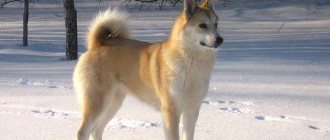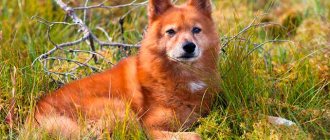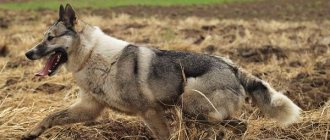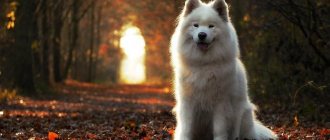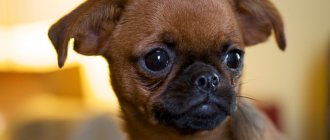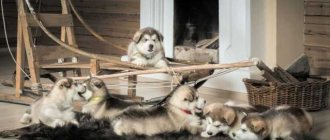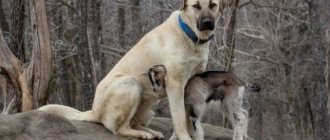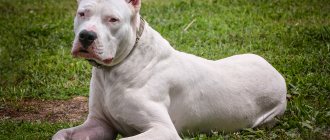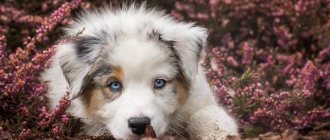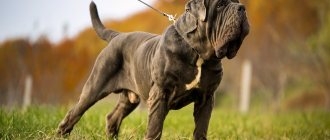The Russian-European Laika belongs to the category of domestic breeds of medium-sized hunting dogs. The special qualities of this dog are increased endurance and an enthusiastic attitude to work. The husky has a complex character, but a competent approach to education will make this dog a reliable companion who will guard your home or go hunting with you.
History of the Russian-European Laika breed
The Russian-European Laika, as an independent breed, was created according to plan.
In 1949, Soviet breeders decided to give hunters another type of hunting dog, using the gene pool of the Karelian, Arkhangelsk, and Komi Laika as a basis. However, the most difficult thing for specialists turned out to be not to cross individuals from the listed offspring (such matings have long been practiced by amateurs), but to bring the resulting offspring to a single type. As an example: by the middle of the 20th century in the USSR there were about ten varieties of Russian-European huskies that had a very distant resemblance to each other. One of the very first and most prolific participants in the experiment is a dog named Tuzik, who belonged to the breeder Sh. A. Isaev. This native of the Komi Laika helped the birth of dozens of Russian-European Laika puppies, essentially becoming the official great-grandfather of the breed. As for the formation of a single exterior, it only happened in 1964, although work on individual lines of the breed continued until perestroika times. It is known, for example, that the most popular branches of Russian-European huskies originated from the male dogs Putik, Bublik and Sharik, and their representatives received from their ancestors excellent external characteristics and developed hunting instincts.
Since the early 70s, new breed groups of Russian-European Laikas began to appear. These are the Jack and Joy lines known to all modern breeders. Unfortunately, already in 1979, breeding hunting huskies lost its popularity, which was facilitated by the state ban on shooting squirrels. And although by that time the breed had made a good exhibition career, and a year later even received FCI registration, this fact had a negative impact on its development. Today, you can meet the Russian-European Laika hunting less often than its relatives, the Westerners. However, these versatile fishermen still have fans, which has helped them not to disappear and also maintain their performance characteristics.
Video: Russian-European Laika
Pros and cons of the breed
The main disadvantages of this breed are the attention it pays to walks and physical activity, the stubborn nature of the dog and a clearly expressed desire to show everyone its leadership intentions.
Among the advantages are ease of care, no difficulties in nutrition, beautiful appearance, developed hunting abilities, increased endurance and strong health.
Breed standard Russian-European Laika
Russian-European Laikas have a very memorable appearance, which is partly due to the meager palette of colors. The dimensions of the representatives of the breed are average, the muscles are dry, and the dogs do not look thin-boned. The height of an adult male Russian-European husky is 52-58 cm; females - 48-54 cm. In general, “girls” have a more elongated silhouette (extension index in the range of 100-105), since this constitutional feature is necessary for bearing offspring. In other respects, males look brighter and more respectable than females, although they do not show significant advantages in work.
Head
Wedge-shaped outlines are typical for the heads of all Russian-European huskies. Between the dry, sharp muzzle and the skull there is a noticeable stop, which seems very sharp due to the convex brow ridges. The muzzle itself is shorter than the skull, while its upper line is parallel to the line of the forehead. The back of the head is rounded, with an easily palpable tubercle and parietal crest.
Lips, teeth and jaws
Elastic lips, tightly pressed to the jaws, do not form saggy jaws. The teeth are massive, even, closely spaced in a row. The only appropriate type of bite is a scissors bite.
Eyes
The Russian-European Laika has dark brown small eyes, which are characterized by a slightly slanted eyelid.
Ears
The shape of the ear is triangular, while the base of the hearing organ is wide and the tip is sharp. The ear position is erect. The ear membrane is small in size and extremely mobile.
Neck
Optimal proportions are when the length of the animal’s neck and head are the same. To the touch, the neck is very muscular, dry in outline, set in relation to the body at an angle of 45° to 50°.
Frame
Russian-European huskies are dogs of moderately strong build with a wide chest reaching down to the elbows and a straight, but not long, back. The animal's loin is convex, with a developed muscle corset. Belly with a clearly defined transition from the sternum to the abdominal area. The cereal zone is quite short, with a slight slope.
Limbs
REL's legs are dry, with well-pumped muscles, located parallel to each other when looking at the animal from the front. The shoulders are moderately oblique, the elbows are large, directed backwards. The pasterns are medium in size and have a slight slope.
The hind legs are formed by long shins and almost vertical metatarsals. The paws have the shape of a regular oval, thanks to the fingers compressed into a ball. Dewclaws are not welcome.
Tail
The husky's tail is crescent-shaped or ring-shaped, curved towards the back and pressed to the outer side of the thigh. When unfolded, the tail reaches the tarsal (hock) joint or is located at a distance of 1-2 cm from it.
Wool
The coat of the Russian-European Laika is a hard, straight coat and a thick undercoat layer. The dense hair covering the dog's head and ears is very short. The shoulders and neck are “dressed” in a rich spine, forming an expressive “collar”, and behind the cheekbones are stylish “sideburns”. Males have longer hair on the withers. The hair on the legs is short, close-lying, slightly lengthening only on the back of the limbs. There are neat feathers on the hind legs. Between the toes, the fur grows like a thick brush, while the paws are covered with short and smooth hairs. The tail is without dewlap, but with an elongated straight spine on the lower part.
Color
Russian-European huskies are born black and piebald, completely white, and also with a solid black color.
Possible defects
Serious defects in the exterior, for which the exhibition score is reduced, are called defects. For Russian-European Laikas these include:
- deviation from the height recorded by the standard by more than 2 cm;
- specks on the body, as well as specks that do not match the main color on the legs and head;
- the coat is loose, wavy or curly;
- long head, massive muzzle without stop;
- hanging or semi-erect ears;
- discord;
- hunchback and barrel chest;
- clubfoot or with splayed legs;
- straight or saber tail.
Description of the breed
The main goal pursued by dog handlers was to create a universal hunter that was easy to train. The dog has the following external standards:
- The body constitution is dry and fit.
- The head is wide, wedge-shaped without folds of skin.
- The eyes are oval, not large, the iris is dark brown.
- The tip of the nose is pigmented black, as are the thin lips.
- The ears are located not far from each other, erect, in the form of triangles.
- The limbs are straight, even, parallel, muscular and strong.
- The tail is high-set, long, curled into a donut and laid on the lower back.
- The back is straight and strong.
- The coat is quite hard, of medium length, slightly shorter on the face and limbs, but on the contrary longer on the chest, neck and tail.
- Acceptable colors are black and white or piebald.
- The maximum height at the withers can reach fifty-eight centimeters.
- The average weight is fifteen kilograms.
Character of the Russian-European Laika
The Russian-European Laika is a dog in love with its owner, and at the same time with all his associates, from family members to friends. Representatives of this family, in principle, are not prone to aggression towards humans, and when it comes to children, huskies immediately turn into the most good-natured and forgiving creatures in the Universe. The breed's territorial instinct is very moderately developed, so its representatives make mediocre watchmen. However, some breeders specifically cultivate protective qualities in their charges. Such individuals are noticeably more suspicious than their relatives and are no longer so loyal to strangers. If you need a dog that can be involved not only in hunting, but also in a simplified version of the ZKS (protective guard service), look for a seller who specializes in breeding guard huskies.
The main weapon in the fight against suspicious guests, available in the arsenal of every Russian-European husky, is a loud bark. By the way, about the “vocal abilities” of the breed: REL are happy to raise their voice with or without reason, and especially piercing concerts are staged by bored individuals. Accordingly, if you keep a Russian-European Laika in your apartment and are often away on business, get ready to ruin your relationship with your neighbors, who are forced to be unwitting listeners to your pet’s musical exercises.
The patience of Russian-European Laikas has become something of a legend, so a properly trained dog will always allow its owner to pull a bowl of food out from under its nose and will suppress any counter-protest. At the same time, dogs react sharply to unfair punishments, so before you slap a dog on the nose with a newspaper, think carefully about whether the pet deserves such treatment. Also consider the exercise needs of the breed. If the Russian-European Laika does not go hunting for a long time and at the same time lives in the house, destruction of the interior is inevitable. And the point here is not in the obstinate nature of the relics, but in natural instincts that do not find application in everyday life.
Origin story
Laikas are one of the most ancient dogs that developed independently, without human intervention. Animals were popular not only in the north, but also participated in game hunting in the middle zone, as evidenced by frescoes from the times of Kievan Rus.
Yes
11.11%
While I'm thinking
33.33%
Has already!
55.56%
They tried to breed pointy-eared northern huskies at the end of the 19th century, and in the early 20s. 20th century The dogs appeared at the First All-Union Dog Show under the names Cheremis and Zyryans. These dogs represented a fairly diverse group, which subsequently became the basis for future breeds of the Karelian-Finnish, Russian-European, Western and Eastern Siberian Laika.
The official canine history of REL began relatively recently, in 1947. Scientists Kuhn and Shereshevsky developed a plan and began to breed four separate varieties of the Western European husky. Selection was rapid and was based on the dogs' conformation. The basis of the Russian-European type was a pair of a purebred West Siberian husky and a hybrid animal with an attractive black and white color.
The first REL standard was approved in 1952. Over the course of one twenty years, several breeding lines were formed, and the number of representatives of the new breed grew to a thousand. The standard of appearance of Russian Laikas became stricter and was fully formed by 1980, when it was adopted by the International Canine Federation.
Hunting with Russian-European Laika
Russian-European huskies are universal hunters, in Russian realities they work excellently on both game and any animal. In addition to its sense of smell, the breed uses sight and hearing in its search, which makes hunting with reels as productive as possible. In addition, Russian-European Laikas are distinguished by the breadth and speed of their search, which helps them successfully compete with Westerners. A very important nuance: different techniques for working with game and animals, found in representatives of different breed lines. Typically, most relics work with their lower senses, following the scent directly, and only occasionally using their auditory receptors.
Some huskies belong to the high-sniffing type, that is, they are guided by the smell coming from the ground and distributed by the lower layers of air. Moreover, under different conditions, the dog can change its reconnaissance technique, moving from the upper to the lower scent and back. A separate category of REL are those who hunt by hearing. The sensitivity of such individuals is slightly less developed, therefore, in the process of pursuing prey, the animal often stops, then runs towards the sound and only barks at the prey in the end. In all respects, spirit huskies are considered ideal hunters, having equally developed sense of smell and hearing, but there are much fewer such individuals, and they are difficult to find.
Some experts recommend specially training your pet's hearing, starting from puppyhood. The Laika is taught to listen to the whisper of its owner, to pay attention to the sounds of living nature - the cries of birds, the knocking of a woodpecker on a tree. However, such exercises do not always give the desired result, since individuals with a dominant sense of smell will still prefer to rely on their nose rather than their own ears.
Shepherd huskies
Representatives of this species of huskies, as a rule, do not have pronounced hunting instincts. Their main purpose is grazing livestock. This category includes:
- Nenets varnish;
- Norwegian Buhund.
Unlike hunting representatives, shepherds do not show pronounced hostility towards other animals.
Nenets
This is a universal type of dog, used as a hunter and shepherd, as evidenced by the second name - the reindeer spitz. It is one of the oldest indigenous breeds in Russia.
In the northern part of the country, the Spitz is mainly used for herding deer. Rarely used as a fur-bearing animal hunter, wild deer.
The height of dogs at the withers varies from 40 to 52 cm. Males are slightly larger than females. Acceptable colors are white, black, piebald, brown of any intensity, zone gray, red. The Reindeer Spitz has elongated guard hairs and a thick undercoat, which create the appearance of a lush coat.
Norwegian Buhund
Known as the Norwegian Husky or Norwegian Shepherd. The breed originated in Norway. The dog has compact dimensions: males are 43-47 cm tall, females are 41-45 cm tall. Animals weigh from 12 to 18 kg. Recognized by the International Film Festival.
According to the standard, 2 colors are preferred: black and wheaten, varying from light red to golden red. A mask and the presence of small white spots on the fur are also acceptable.
This breed of Laika dog is used as a watchman, shepherd and companion. The Norwegian Buhund has a highly developed guarding instinct.
The main drawback is frequent barking, which must be eliminated from puppyhood through proper training.
Education, training, grooming
The training of the Russian-European husky is based on helping the animal become a professional getter of forest and field trophies. The remaining service commands are discarded. At the same time, with a pet living in urban realities, you can take a UGS (controlled city dog) course. True, according to experienced hunters, such “education” does not have the best effect on the instincts of the breed. As a result, dogs trained in service commands perform much worse.
You can groom your future hunting husky from as early as three months, regardless of the time of year. Start with short walks in the forest and try not to make noise so that the puppy can listen to new sounds. The grooming technique also depends on what type of animal and game is to be hunted. For example, to work with waterfowl, you need to teach your puppy to overcome his fear of bodies of water. It is better to hunt the Russian-European husky hazel grouse in the fall and in those forests where young feathered animals definitely live.
Important: Russian-European huskies, who live in city apartments for years and go hunting only once a season, may lose their keen sense of smell. Usually the sense of smell is restored during work, but this does not happen immediately.
Mandatory skills for hunting huskies: walking next to the owner, willingness to sit down and give an object on command, including from the water. Breeders recommend organizing the training process with the help of additional equipment: a 20-meter leash with a carabiner, a plain whistle, a carrier (a piece of wood or a soft fabric toy). It is acceptable to use a thin rod when practicing the “No!” command. Traditional scheme: a dog caught picking up food from the ground is held at the “crime scene” and whipped sharply, but not too hard, with a vine. If you don’t have a rod at hand, it’s useful to pull the leash and voice the command. At the same time, it is strictly forbidden to hit a Russian-European husky with your hand or leash.
By the age of six months, a Russian-European Laika puppy is usually socialized: he knows his name and responds to it, is accustomed to walking on a leash, and has fit into the hierarchical system of the family in which he lives. At 6 months the animal can be prepared for hunting and trained. The first command to learn is “Near!” The owner takes the Russian-European husky outside, gives an order, patting himself on the thigh and at the same time pulling the puppy towards him by the leash. The strap is then gently released and the pet receives a rewarding pat or treat. By the way, for the latter it is better to buy a belt bag. Over time, the husky will understand where the owner hides the treats and will try to earn them.
When the Russian-European husky learns to walk side by side, start practicing the “Sit!” command. Everything is traditional here: after the order, the pet is gently pressed on the sacrum, forcing it to sit down on its hind legs. At the same time, the puppy is taught to give diarrhea correctly. The scheme is simple: shake a cloth stuffed animal in front of the animal’s nose. When the pet begins to grab the object with its teeth, throw it forward with the command “Give!”, and after the husky picks up the stuffed animal, gently take it away, rewarding the puppy with a treat.
If you plan to go waterfowling, teach your Russian-European Laika to swim. Only without extremes: throwing a puppy into the water, as home-grown “pros” do, is a harmful and empty activity that will provoke hydrophobia in the animal and nothing else. It is better to start by crossing shallow reservoirs (the owner goes first, followed by the puppy) and only in the warm season, since dogs also need time to get used to and harden. As for baiting large animals, it can be done at stations and with animals at least 1 year old. And of course, take into account the individual characteristics of your own pet: some huskies are not vicious enough for such an activity and are often frightened by potential prey that is larger than them.
Maintenance and care
Despite the growing popularity of apartment keeping of Russian-European huskies, the ideal housing for the breed remains a spacious enclosure, facing the south with a lattice and equipped with a warm booth. The mandatory “walking minimum” for the Russian-European Laika is from 2 to 3 hours a day, and it does not matter where your pet lives - in an apartment or in the courtyard of a country cottage.
You should not be afraid of the destructive behavior of Russian-European huskies living in houses. If the dog is walked and hunted enough, it will not cause chaos. The exception is puppies, who taste the world around them, but a compromise can be found with them. Provide your puppy with plenty of toys and frequent treats of cartilage and flat bones to give your puppy something to occupy his teeth.
Hygiene
Care for apartment and enclosure huskies will be different. The former, as a rule, are poorer dressed, since they live in a warm place, therefore, during winter hunting, such individuals freeze faster. Residential Russian-European huskies shed throughout the year, so brushing your pet several times a week will save your home from hairballs. Enclosure dogs shed their “coats” seasonally, that is, twice a year, which significantly saves the owner’s energy. Theoretically, yard huskies need to be brushed only during the molting period, but in practice this has to be done much more often, especially if the animal often goes hunting, where it can pick up burrs.
Important: Russian-European Laika puppies should not be washed. Only adult dogs are allowed to bathe, and only in cases where it is really necessary.
The ears of Russian-European huskies are cleaned as they become dirty using hygienic drops and a piece of clean cloth. If the amount of sulfur in the funnel is insignificant, do not disturb your pet in vain: the husky is not a decorative dog that needs to be washed and combed endlessly. The breed's eyes are healthy, so special care is not required for them. Just brush away dust bunnies from the corners of your eyelids and clean your eyes once a week with chamomile infusion and a tissue.
Remove accumulated plaque from your dog's teeth weekly: you can do this with a toothbrush or a silicone brush on your finger. An alternative to classic cleaning is hard treats like sinew, as well as carrots and tomato juice. During the hunting season, special attention should be paid to the legs of the Russian-European husky. If, upon examination, scratches or cuts are found on the paws, treat the wounds with an antiseptic. In winter, it is useful for urban huskies to lubricate their paw pads with protective creams that will protect their skin from toxic road reagents.
Feeding
Russian-European huskies are often fed animals they have hunted. The only caveat of this menu: a dog that eats hunting trophies will have to be treated for helminths more often. If work in the forest does not work out, the pet’s diet is based on any lean meat (from beef to poultry), raw tripe and offal. Once a week, meat can be replaced with fish fillet. To make dog dinners a little cheaper, they also add cereals – buckwheat and rice.
It is useful to dilute the meat component with seasonal fruits, young herbs, and vegetables. Russian-European huskies will not refuse fermented milk products, so get ready to periodically buy low-fat kefir, cottage cheese and fermented baked milk for your pet. To improve the appearance and thickness of the coat, it is recommended to treat your dog with a teaspoon of unrefined vegetable oil - it can be sunflower, olive or flaxseed oil.
What to feed
The puppy's nutrition depends on its age. In the first 2 months they are fed 6 times a day, increasing to 3 feedings by 5 months.
An adult husky is mainly fed meat and fish 2 times a day. The dog is fed moderately before going hunting to increase the desire to catch game.
Additionally, dogs should eat porridge and vegetables. The diet should be varied. Consumption of carbohydrates provides the necessary energy.
Avoid overeating. The number and volume of feedings depends on activity and lifestyle
They should not eat sweet and smoked foods, baked goods, all types of legumes, and potatoes.
Health and diseases of Russian-European huskies
In purebred huskies, there are practically no hereditary diseases, with the exception of hip dysplasia, the mechanism of which is not yet fully understood. At the same time, you will still have to monitor your pet’s health, given its active lifestyle. For example, REL are often injured while hunting and can contract various infections there. Treatment of representatives of the breed against ectoparasites, as well as with anthelmintic drugs during the hunting season, is mandatory. Sometimes Russian-European Laikas are diagnosed with epilepsy and urolithiasis. In addition, some individuals may develop food allergies, which can be easily combated through a properly formulated diet.
How to name a pet
There are a lot of options for nicknames for the REL dog. You can name your pet after your favorite actor or musician (Jenny, Monica, Jack, Johnny, Celine, Britney, Justin). Some owners prefer to turn to history, naming their pet Brutus, Caesar, Spartacus, Margot, Cleo.
Monosyllabic, easy-to-pronounce nicknames like Bob, Thunder, Zeus (for boys), Marge, Claire, Meg, Dot (for girls) work well.
Note! The presence of voiced consonants in the name will help the pet quickly remember it and associate it with itself.
This is a brief description of the unique breed of domestic huskies, which are distinguished by their attractive appearance and excellent character. They will become loyal friends to their owner for many years and will help on the hunt. At the same time, caring for them is very simple.
How to choose a puppy
- Collect as much information as possible about the sires of the litter: presence of exhibition diplomas, pedigrees, exterior, tests for genetic dysplasia.
- Do not look for show puppies from breeders who breed purely working lines and vice versa. Hunting huskies will never have such a glamorous exterior as their show relatives, and show dogs are not as productive when hunting.
- Choose a female Russian-European husky if you are going to “work the fur” - when hunting squirrel and sable, “girls” are always more collected and prudent.
- For wild boar hunting, it is better to choose males - they are more passionate, angrier and an order of magnitude bolder than females.
- If the seller has not provided a litter inspection certificate, there is a high probability that there are mixed breeds in it, because of which the breeding commission refused to issue the documents to the breeder.
- Try to visit the kennel in advance so as not to pick up the last remaining puppy. Assess the entire litter: it is ideal if all the babies are approximately the same size.
- Maximum attention should be paid to the shape of the puppy’s head and bite, since it is these exterior indicators that determine the breed of Russian-European Laikas.
- It is not recommended to take the most dominant puppy in the litter: as he matures, such a puppy will try to lead in hunting and in everyday life.
- Test the hearing acuity and sensitivity of Russian-European Laika puppies before purchasing. Click your fingers above the kids' heads and see which one reacts first to the noise. The sense of smell is tested with a bowl of food placed at a distance from the animals. The puppy that smells the treat first will be the most instinctive in the litter.
- When buying an adult dog with a show diploma, pay attention to how it behaves in the ring. If the pet does not walk next to the owner and barks angrily at everyone, hunting with such a dominant will not be successful.
Price of Russian-European Laika
It is easy to buy a Russian-European Laika within the Russian Federation, and for quite modest money. It is already more difficult to purchase a purebred REL with club documents. The fact is that most hunters do not see anything wrong with mating their charges with representatives of other breeds or even mestizos. Accordingly, it will no longer be possible to go to an exhibition with such a dog.
The most expensive offer on the market are adult Russian-European huskies with working or exhibition diplomas and a decent pedigree. The cost of such dogs can range from 30,000 to 100,000 rubles. Club puppy from good ones for 10,000 - 15,000 rubles. As for mixed-breed babies, they can often be obtained for free or for a symbolic price. True, no one will guarantee the safety of hunting instincts in such animals.
Feeding your pet
The owner chooses the feeding mode himself. Both the use of a natural diet and dry industrial food from leading brands in Europe or Russia are allowed. In the first case, the pet is additionally given vitamin complexes. In the second, suitable class lines from super-premium and higher are selected.
With any food system, you should not give your husky leftovers from the human table, richly flavored with spices and seasonings. Access to fresh water should be available around the clock.
Dog on a walk
